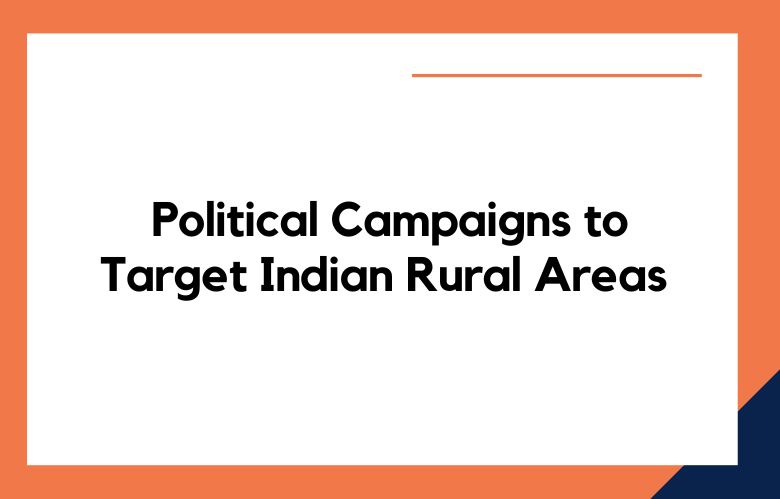With political campaigns being a fundamental part of the democratic process, it is crucial to note that political campaigns in rural India differ significantly from those in urban regions.
Given the country’s economic and cultural diversity, planning a successful political campaign in rural India can be challenging. However, with proper planning and execution, a campaign can reach a broader audience in rural areas and be successful.
We will look at strategies you can employ to ensure your political campaign meets its objectives in rural India.
What political campaigns will be targeted in the rural areas of India?
India is a vast country with a diverse range of cultures and traditions. General elections in India are a political competition and reflect the country’s socio-economic landscape.
Political parties face an enormous challenge in identifying key issues that resonate with the significant percentage of the population living in rural areas of India.
How to Run Effective Political Campaigns in Rural Areas of India
In India, the rural areas represent the most significant voter base in all elections. Despite this, many political parties need help to connect with people in these regions, leading to fewer votes.
One of the reasons why this happens is because political campaigns are primarily targeted at cities and towns.
However, with the changing times, politicians must shift their strategies to reach out to voters in rural areas. The good news is that it isn’t that difficult. We will discuss how to run effective political campaigns in rural India.
How to Conduct Political Campaigns to Target Rural Areas in India Effectively
India has diverse cultures and demographics, and effective political campaigns must be tailored to specific regions. With most of the population residing in rural areas, conducting political campaigns becomes necessary.
Rural areas often need to be addressed more, challenging political campaigns that resonate with the community. However, running a successful political campaign in rural areas is possible with the right strategies and tactics.
We will discuss some practical techniques to target rural areas in India.
Targeting Rural Indian Voters: Strategies for Political Campaigns
India is a vast and diverse country, and political campaigns must adapt their strategies depending on their target region. While cities are always a key battleground, it’s also essential for politicians to engage with constituents in rural areas.
Understanding the Local Issues
In India, local issues can vary significantly from region to region. While national-level issues certainly matter, campaigns must address concerns specific to the community they’re targeting.
Before launching a political campaign in a rural area, ensure you understand the unique challenges and opportunities. This may involve conducting surveys, reaching out to local leaders, or even spending time on the ground to get a feel for what’s happening.
Leverage Social Media
Many people assume that rural areas are disconnected from the digital world, but this is only sometimes the case. A growing number of people in rural areas have access to smartphones and social media.
By using digital channels, politicians can reach many potential voters cost-effectively. In addition to Facebook and Twitter, it’s important to consider platforms like WhatsApp, which are incredibly popular in India and are widely used in rural areas.
Focus on Grassroots Activism
Sometimes, the best way to reach rural voters is to go straight to the source. By focusing on grassroots activism, political campaigns can build relationships with local leaders and community members who can help spread their message.
This might involve hosting events, partnering with local organizations, knocking on doors, and engaging in one-on-one conversations. Grassroots activism can be time-consuming and resource-intensive, but it’s often the most effective way to build trust and establish credibility in rural areas.
Use Regional Media
While national news outlets are undoubtedly critical, political campaigns must also engage with regional media outlets.
Local radio stations, newspapers, and TV channels can be incredibly influential in rural areas, and they often have a more targeted audience than national media.
In addition to running ads and appearing on talk shows, you must develop relationships with reporters and editors who can help spread your message.
Be Authentic
It’s important to remember that rural voters want to see authentic politicians. They’ve often grown skeptical of those who make big promises but fail to deliver.
Connecting with people personally is essential instead of relying on flashy campaign ads and pre-packaged messaging. This means being willing to listen, being transparent about your goals and priorities, and demonstrating a genuine interest in their concerns.
Simplify Your Message
In rural India, most people need to become more familiar with complex political jargon than urban dwellers. As such, keep your message simple.
Use universal language that resonates with most people living in rural areas. Avoid using technical language that may confuse or bore your audience. The simpler and more direct your message, the more likely individuals are to hear you and grasp the cause of your political campaign.
Leverage Social Media
Although social media is less prevalent in rural areas than in urban regions in India, more people are now gaining access to smartphones and the internet in rural areas.
Take advantage of these platforms to reach your target audience. Facebook and WhatsApp groups allow you to conduct door-to-door campaigns virtually, reaching a broader audience instantly.
A mix of traditional and social media campaigns can resonate with rural residents and improve the impact of political campaigns in rural areas.
The Grassroots Strategy
To succeed in any political campaign in rural India, you need to connect with the community on the ground level. Please get to know the local influencers, including regional leaders, social workers, and opinion-makers, and engage them in your campaign.
This way, you can learn more about the community’s issues and create personalized solutions to the region’s problems. With the guidance of local influencers, you can launch small community events to connect with the people in your target rural areas.
Be Relevant
Political campaigns that are relevant to the concerns of rural communities have a higher success rate than those that are not. Highlight the issues affecting the people in your target area and communicate how you intend to solve them if elected.
Rural residents face different problems from those in urban areas, and your political campaign should reflect this. To motivate and effectively impact the communities, your campaign should focus mainly on issues affecting rural development, education, and healthcare.
Invest in Door-to-Door Campaigning
Lastly, door-to-door campaigning is essential for establishing a personal connection with rural residents. Unlike urban areas, where rallies, posters, and TV appearances create a more significant public image, rural residents prefer personal engagement.
Knock on your target electorate’s doors, introduce yourself, and listen to their concerns. As you listen and understand their problems, communicate how you intend to solve the issues and encourage them to vote for you.
Conclusion
Political campaigns in rural India demand a different approach than those in urban regions. These strategies can help you plan and launch successful political campaigns in rural India.
Ensure you simplify your message, use social media platforms, rely on grassroots influencers, keep your message relevant, and invest in door-to-door campaigning. Doing this will significantly impact the lives of rural communities and increase your chances of winning in these regions.
Frequently Asked Questions (FAQs)
What are the key challenges in campaigning in rural India?
Challenges include limited internet access, diverse languages and dialects, lower literacy rates, and deep-rooted local issues.
Why is rural outreach important in Indian elections?
Because a large portion of India’s population resides in rural areas, making them critical for electoral success.
What strategies work best for rural political campaigns?
Door-to-door outreach, local influencer engagement, village meetings, folk media, and tailored manifesto promises.
How can politicians build trust in rural communities?
By being physically present, addressing hyperlocal concerns, collaborating with local leaders, and delivering on promises.
What communication channels are most effective in rural India?
Radio, community events, mobile vans, loudspeaker announcements, WhatsApp forwards, and regional TV channels.
Can social media be used for rural campaigning?
Yes, especially WhatsApp and YouTube in regional languages, but digital penetration remains limited in some areas.
What role do local influencers play in rural campaigning?
They serve as trusted messengers, helping political messages resonate with cultural and linguistic relevance.
How can cultural events support political messaging?
By integrating campaign messages into folk songs, dramas, and festival events, parties can build emotional connections.
Should rural campaigns be different from urban strategies?
Absolutely—rural campaigns must reflect local traditions, needs, and communication styles, unlike data-heavy urban campaigns.
How important is language in rural political messaging?
Extremely important—messages must be in the local dialect or language to build authenticity and comprehension.
What type of content resonates with rural voters?
Simple visuals, stories about local development, testimonies from villagers, and relatable issues like farming or water.
How do political parties gather data in rural areas?
Through voter surveys, local cadre feedback, electoral rolls, NGO collaborations, and grassroots intelligence networks.
What mistakes should be avoided in rural campaigns?
Ignoring caste dynamics, using complex jargon, overpromising, and relying solely on digital outreach.
How can parties mobilize rural volunteers?
By involving local youth, SHG groups, farmers’ associations, and leveraging community pride and identity.
What role do Panchayat leaders play in rural political strategy?
They act as gatekeepers, endorsers, and mobilizers, often influencing entire communities with their support.
Is caste-based targeting still relevant in rural India?
Yes, caste dynamics deeply influence voting behavior, and segment-specific outreach is often necessary.
How can logistics be managed during rural campaigns?
Through local resource planning, mobile outreach units, and coordination with district-level party offices.
Are rural voters influenced by national vs. local issues?
Mostly local issues—roads, irrigation, jobs, and subsidies carry more weight than broader ideological narratives.
Can visual branding help in rural campaign recognition?
Yes, consistent use of symbols, colors, and candidate images increases recall, especially among non-literate voters.
What is the future of rural campaigning in India?
It will blend tradition and tech—offline outreach supported by targeted digital, AI-driven insights, and hyperlocal personalization.











